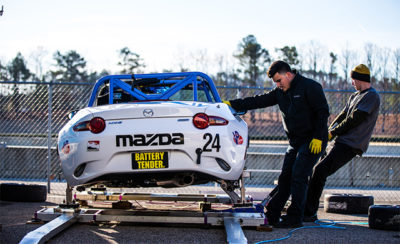Getting a race car’s suspension settings correct can be confounding, but a key step is to figure out whether a problem is the car or the driver.
Getting the setup on a race car correct is tricky. There are so many variables, not to mention types of corners and tracks, that getting the car to behave like you want it to in all conditions is a challenge, if not downright impossible. The first part of understanding setup, however, is exactly that – you want to get the car to behave how you want.
First: Know there isn’t a perfect setup on a car.
Second: Just because a car setup works for one driver, doesn’t mean it’s going to work for another – different skills, different abilities. Some like oversteer, some like more neutral cars.
Conclusion: The big misconception is that there’s a right answer. The reality is that more often than not, there are just wrong answers. If the car isn’t doing what the driver wants it to do, it’s not right.
Now that the question of what is meant by a correct setup, the next question is what part of the car’s behavior is attributable to setup, and what part is driving induced (perhaps error).
“There are many times you will work with guys who confuse what the car is doing and what they are doing,” explains pro coach and driver Andrew Carbonell. “Are they causing the car to have a handling issue, or does the car actually have a handling issue? A very simple example: If we over slow the corner, and we go to throttle too soon, therefore shifting the weight to the back of the car, we cause understeer. If you’re doing this turn after turn, lap after lap, you’re going to complain the car is an understeering pig. You have to make sure you’re driving your car properly and doing what physics allows; if you are, and the car still isn’t responding properly, then it may be a setup issue, or you may have to give up some in one corner to maximize the car in a more important corner.”
The ultimate way to isolate whether a problem is driver- or setup-induced, is data. The driver feedback may be that he’s flat through a corner, and you find out through data that maybe the foot’s not paying attention; maybe it’s not as flat as the driver thought. By looking at the data, and especially if you have the luxury of having comparative data, that is ideal, because you can then easily decipher the problem…you’re braking too early, you’re not on the power here, or you’re generating too much side load because you’re entering too early.
The other thing that can cause confusion, though, is an actual mechanical issue with the car, which can be particularly hard to identify. A great example is if you have a limited slip and the diff opens up and you get a lot of wheel spin. You can drive yourself crazy trying to adjust around that, and it’s really a mechanical problem.
There are some clear indicators of when a problem is setup related. “If it’s overly loose – as soon as you touch the wheel it wants to come around – or it doesn’t want to turn on the way into the corner, then we’ve got obvious issues,” says Carbonell.
Tire temperatures can be a pretty good measure of how close to the target a setup is. Too much temperature spread across the tire is a good indicator that something isn’t right, and that information combined with driver feedback (bounce ideas off a fellow racer if you’re your own crew chief) can go a long way to getting something close. Once you’re in the ballpark and you’ve got a setup that feels good, it’s time to take a step back. “Once you get it close, you really need to polish the driving before you keep knocking away at setup,” says Carbonell.
Think about it – would you rather spend your time under the car making small changes in toe, or analyzing data and video to see where you might be able to improve the car’s behavior through better driving? Small setup changes aren’t likely to make a difference until you’ve nailed the driving.


 ACCESSIBILITY
ACCESSIBILITY